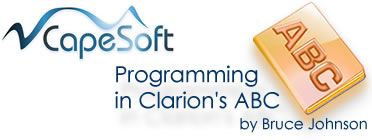| Review | ||||
|
||||
ETC III: Programming in Clarion's ABC by Bruce Johnson
Once again, Bruce Johnson returned to the ETC conference for his presentation of Programming in Clarion's ABC.Bruce has expanded his previous presentation at ETC 2000 to cover significantly more information. For example, attendees of this session received a 137 page book, written by Bruce Johnson, that details all the information discussed. The book for this year's session is approximately three times bigger than before.
Bruce opened with a discussion of some basic ABC terminology and outlined some goals of using ABC, the primary goal being: writing reusable, bug free code.
The information presented this year was simply overwhelming. The topics that Bruce covered included: Windows, Forms, Browses, Views, Reports, Processes, Files, Relations, Errors, Popups, INI files, and Edit In Place. Each topical discussion focused on the ABC Classes involved and how they relate to each other.
Bruce explained the relationships between "Generic" and "Specific" code and helped grasp the concept of "Virtual Methods", or "Pancakes" as he calls them. If your confused by this, don't be alarmed, I was too. Bruce was basically implying that the term "Virtual" is too vague, and should have been called something more meaningful.
Bruce also discussed Interfaces. He explained what they are and how to use them. In each of his discussions, Bruce pointed out major embed points and when we should use them. Along the way, He provided many useful tips and tricks. He also presented some little know facts, including:
- How the Update method of the FileManager Class can cause a performance hit
- How deferring the opening of files until accessed can provide a massive speed improvement
- Why embedding code into the Insert() method of the FileManager Class should also be embedded into the TryInsert method as well
- How to view error log history and/or save it to disk
- How to get a list box to behave like a spreadsheet
- What the C55util function library is and how to use it
All in all, too much information was discussed than can be included in this report. At times, even Bruce skimped on the details, but would direct us to read the book, because the information is discussed there.
There was an additional cost of $50 to attend this session. Even if you were unable to attend, it is my opinion that the book alone is worth the money spent. The book is laid out quite nicely. The first section is intended to be an introductory tutorial, while sections two and three cover more advanced topics. Compared to the cost of many computer books these days, the cost to attend this session was a bargain. If you have the opportunity in 2004, you should definitely plan on attending this session.
© 2002, Online Publications, Inc. Reproduced
with permission.
© 2012 CapeSoft Software CC
